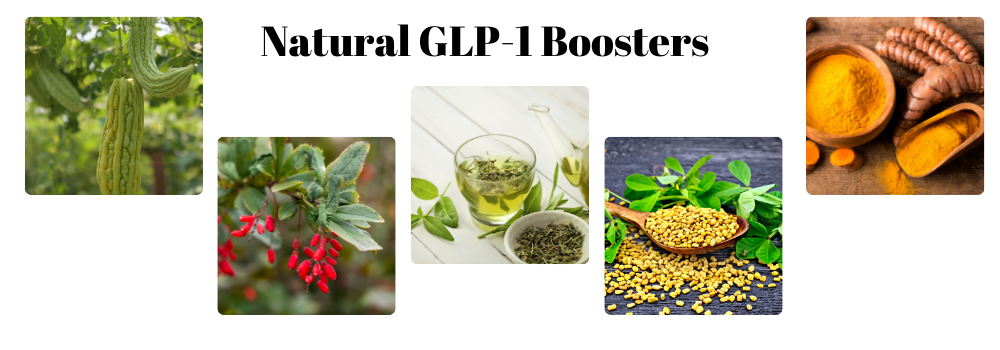Do Natural GLP-1 Work?
Sep 22nd 2024
Exploring Natural GLP-1: How They Work, How to Use Them, and Their Effectiveness
In recent years, GLP-1 (glucagon-like peptide-1) receptor agonists have gained significant attention for their role in managing blood sugar levels and promoting weight loss. These synthetic drugs mimic the function of naturally occurring GLP-1, a hormone that helps regulate insulin secretion and appetite. But did you know there are natural alternatives that may offer similar benefits?
In this blog, we’ll explore natural GLP-1 alternatives, how they work, their effectiveness, and real-world case studies to provide insight into how they might support your health.
What Is The Science Behind GLP-1 Working?
The mechanism behind GLP-1 (glucagon-like peptide-1) involves its role in regulating blood sugar levels, insulin secretion, and appetite control. Here’s how it works:
1. Secretion of GLP-1:
GLP-1 is a hormone produced in the intestinal L-cells of the small intestine, primarily in response to food intake, especially when carbohydrates and fats are consumed.
2. Stimulating Insulin Secretion:
Once GLP-1 is released into the bloodstream, it binds to GLP-1 receptors on pancreatic beta cells. This stimulates the pancreas to produce and release insulin. Insulin helps lower blood sugar levels by facilitating the uptake of glucose into cells, where it can be used for energy.
3. Inhibiting Glucagon Release:
GLP-1 also reduces the secretion of glucagon from pancreatic alpha cells. Glucagon is a hormone that normally raises blood sugar levels by promoting the production of glucose in the liver. By inhibiting glucagon, GLP-1 prevents the liver from releasing too much glucose into the bloodstream, helping to keep blood sugar levels under control.
4. Slowing Gastric Emptying:
GLP-1 slows the gastric emptying process, meaning it takes longer for food to leave the stomach and enter the intestines. This creates a feeling of fullness, or satiety, which reduces appetite and food intake. This effect is beneficial for weight management and controlling blood sugar spikes after meals.
5. Promoting Satiety:
In addition to slowing gastric emptying, GLP-1 also acts on the hypothalamus, a region in the brain responsible for regulating hunger. By activating GLP-1 receptors in the brain, it promotes a sense of satiety, further reducing appetite.
6. Neuroprotective and Cardioprotective Effects:
Emerging research also suggests that GLP-1 has neuroprotective and cardioprotective effects, potentially supporting brain health and reducing the risk of cardiovascular diseases. These effects are still being explored but add to GLP-1’s overall health benefits.

Summary of GLP-1 Mechanism:
- Stimulates insulin release, lowering blood sugar levels.
- Inhibits glucagon, preventing excessive glucose production in the liver.
- Slows gastric emptying, prolonging the feeling of fullness.
- Promotes satiety, reducing food intake.
- Supports insulin sensitivity, helping the body use insulin more effectively.
This multifaceted mechanism makes GLP-1 a powerful hormone for regulating blood sugar, managing weight, and maintaining overall metabolic health.
What is GLP-1 and How Does It Work?
GLP-1 is a hormone secreted by the gut in response to eating. It serves multiple roles in managing glucose metabolism and appetite regulation:
- Stimulates insulin release from the pancreas, lowering blood sugar levels.
- Inhibits glucagon release, which helps reduce the production of glucose in the liver.
- Slows gastric emptying, making you feel full longer, which can reduce food intake.
- Improves insulin sensitivity, which is crucial for those with insulin resistance or type 2 diabetes.
Synthetic GLP-1 receptor agonists, like semaglutide or liraglutide, have been shown to effectively lower blood sugar and aid in weight loss. However, these medications can be expensive and come with side effects such as nausea and gastrointestinal discomfort. This is where natural GLP-1 alternatives may provide a more holistic approach.

Natural GLP-1 Boosters
Certain foods and herbs can naturally boost GLP-1 secretion or mimic its effects. Here’s a list of some of the most potent natural GLP-1 boosters:
- Bitter Melon (Momordica charantia)
Bitter melon is often used in traditional medicine for managing blood sugar levels. Studies have shown that bitter melon can help stimulate GLP-1 secretion, leading to improved insulin sensitivity and lower glucose levels. It contains charantin and polypeptide-p, both of which have insulin-like effects.
- How to Use: Bitter melon can be consumed as a juice, in capsule form, or added to meals.
- Berberine
Berberine is an alkaloid found in plants like goldenseal and barberry. It has been widely studied for its ability to lower blood sugar and improve metabolic health by enhancing GLP-1 secretion and insulin sensitivity. Berberine also helps regulate gut microbiota, which plays a role in metabolic health.
- How to Use: Berberine is available as a supplement. Typical dosages range from 500 mg to 1,500 mg per day.
- Green Tea (Camellia sinensis)Green tea contains compounds like catechins that have been shown to enhance GLP-1 secretion. Drinking green tea regularly may help improve insulin sensitivity and aid in weight loss by regulating appetite.
- How to Use: Drink 2-3 cups of green tea daily for best results.
- Inulin (Prebiotic Fiber)
Inulin is a type of prebiotic fiber found in plants such as chicory root and Jerusalem artichoke. It promotes gut health and has been shown to boost the secretion of GLP-1, helping to regulate blood sugar and appetite.
- How to Use: Inulin can be added to smoothies, drinks, or consumed as a supplement.
- Fenugreek (Trigonella foenum-graecum)Fenugreek seeds are known for their ability to lower blood sugar levels. Research indicates that fenugreek can stimulate the release of GLP-1, making it a great natural alternative for blood sugar control.
- How to Use: Fenugreek seeds can be soaked overnight and consumed in the morning or taken as a supplement.
- Curcumin (Turmeric)Curcumin, the active compound in turmeric, has been shown to have a range of health benefits, including improving GLP-1 secretion. It is particularly useful for improving insulin sensitivity and reducing inflammation.
- How to Use: Curcumin supplements or adding turmeric to meals can provide benefits. For better absorption, pair it with black pepper.
How Effective Are Natural GLP-1 Boosters?
The effectiveness of natural GLP-1 boosters can vary from person to person. However, research shows that incorporating these herbs and foods into your diet may significantly improve blood sugar control, especially when combined with a healthy lifestyle.
Let’s look at some case studies demonstrating the effectiveness of natural GLP-1 boosters.

Case Study 1: Bitter Melon for Type 2 Diabetes Management
Background: A 55-year-old male with type 2 diabetes had difficulty managing his blood sugar levels despite medication. He was introduced to bitter melon as a natural GLP-1 booster to complement his treatment.
Results: After three months of daily bitter melon supplementation, the patient’s fasting blood sugar dropped from 140 mg/dL to 115 mg/dL. Additionally, his HbA1c levels improved, and he reported feeling more energetic with fewer sugar crashes.
Conclusion: Bitter melon effectively boosted GLP-1 secretion, leading to better blood sugar control alongside traditional medication.
____________________________________________________________________________________________
Case Study 2: Berberine for Blood Sugar and Weight Management
Background: A 42-year-old woman struggled with insulin resistance and weight gain. She began using berberine supplements to address both concerns.
Results: After 12 weeks of berberine supplementation (1,000 mg/day), she experienced a 10% reduction in body weight and improved insulin sensitivity. Her blood sugar levels stabilized, and her appetite was more controlled, thanks to enhanced GLP-1 activity.
Conclusion: Berberine proved to be a powerful natural alternative for regulating both blood sugar and appetite through GLP-1 stimulation.
Case Study 3: Green Tea for Appetite Control
Background: A 30-year-old male wanted to lose weight and control his appetite. He began drinking 3 cups of green tea per day.
Results: Over two months, he reported a reduction in cravings and late-night snacking. His weight decreased by 5%, and he felt more satisfied after meals, likely due to increased GLP-1 activity from the green tea.
Conclusion: Green tea effectively boosted GLP-1 levels, helping to regulate appetite and support weight loss.
Are Natural GLP-1 Boosters Right for You?
When using natural GLP-1 boosters like bitter melon, berberine, green tea, and other herbs, it’s essential to keep a few key factors in mind for achieving successful results.
Firstly, consistency is crucial. Unlike pharmaceuticals, natural remedies take longer to show noticeable effects. Whether you're using these herbs as supplements, teas, or food additives, regular daily use is necessary for the compounds to build up and work effectively in your body. This requires patience, as it may take several weeks or even months before you see improvements in blood sugar control or weight loss.
It’s also helpful to monitor your progress by tracking your blood sugar levels, weight, or energy over time. This way, you can gauge the gradual improvements, even if they aren’t immediately obvious.
To maximize the effects, it’s important to combine these natural remedies with a healthy lifestyle. Regular exercise, a balanced diet rich in whole foods, and proper sleep are vital for enhancing the benefits of natural GLP-1 boosters. For example, pairing green tea or berberine with a low-carb diet can further amplify their impact.
While natural GLP-1 boosters are generally safe, it's always wise to consult a healthcare provider before starting, especially if you're taking medications for blood sugar or other health conditions. Some herbs, such as berberine, may interact with medications, and professional guidance can help you find the right dosages and ensure safety.
Quality also matters—choosing high-quality, lab-tested herbs ensures potency and effectiveness. Poor-quality products may contain contaminants or lack the potency needed to deliver desired results, so always buy from trusted sources.
Lastly, personalize your approach. Everyone’s body responds differently to natural remedies, so it may take some experimentation to find the right dosage or combination of herbs that works best for you. Start with a lower dose and gradually increase as needed while monitoring your body’s response.
By staying consistent, combining these remedies with a healthy lifestyle, and consulting a healthcare provider, you can effectively use natural GLP-1 boosters to help manage blood sugar levels, improve insulin sensitivity, and control appetite. Although they may not act as quickly as synthetic GLP-1 agonists, they offer a gentler, holistic approach without the side effects associated with pharmaceuticals. With patience and commitment, you can enjoy their long-term benefits in supporting your health.

Final Thoughts
Natural GLP-1 boosters, such as bitter melon, berberine, green tea, and turmeric, provide effective ways to regulate blood sugar, manage weight, and support overall health. With a growing body of research and real-world case studies, these herbs and foods offer promising alternatives for those seeking to enhance their health naturally.
Ready to try these natural GLP-1 boosters? Start by incorporating some of these powerful foods and herbs into your daily routine and experience the difference for yourself!

